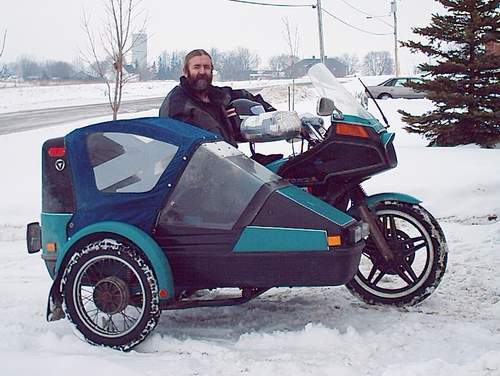Questionnever ridden one, but are sidecars stable enough in the element to be ridden in the winter. snow, ice, etc...
Answer
 winterbiker
winterbiker
The short answer is: Yes. I'm living proof that sidecar outfits are viable winter transportation. I live about 1.5 hours northeast of Toronto and drive my outfit to work every day from October to April, no matter what the weather.
An old piece of folk wisdom says that a milkmaid's stool has 3 legs because that makes it harder to tip over. Sidecar outfts are a lot like that. Simply put, they don't fall over.
The big advantage over a car is that you can actually feel the road underneath you. In a car or truck, with all of the linkages, the gearbox, the power assist &c you can't really tell whether you are on ice until you try to steer or brake and then it's too late. On an outfit, all there is between where you hold on and where the front tire touches the ground is the suspension so you can tell as soon as you drive onto a slippery surface and you can slow down before you get into trouble.
When you hit a slippery spot on the road the back end will start to skate around as the back tire looses grip. If you let off the throttle a bit the tire will regain it's traction with no drama at all.
A properly set up outfit can be just about the most stable vehicle on the road in the hands of a driver who knows it's limits.
You have to keep in mind, though, that, contrary to what the DMV and your insurance company will try to tell you, a sidecar outfit is NOT just a motorcycle with an accessory. It IS a completely different vehicle. A sidecar outfit is as different from a car as a bike is and as different from a bike as a car is. About the only thing it has in common with a solo bike is the location of the controls.
You will need to learn to drive all over again, so if you are seriously considering driving a sidecar in the winter get it before there is snow so you can learn on dry roads first.
To learn more about driving a sidecar outfit, go to http://www.sidecar.com/links3.asp and download and read the manuals.
Without going into it ad nauseum, if you are really serious about winter biking, my best recommendation is a small(er) bike and sidecar that you don't care about keeping really nice and wear gear that works.
Smaller:
I had a GL1000/Dnepr sidecar outfit for almost 5 winters and it was really too heavy for pushing out if it got snowed on in the parking lot at work. Also, too much power makes it easier to break the back wheel free when the road is slippery and heavier = harder to stop in bad conditions. Generally, a 50-65 HP bike that weighs in the 500-600 Lb range and a sidecar that weighs about 1/4 - 1/3 the weight of the bike should work well.
Something you don't care about keeping nice:
Two words: road salt. You don't want to do this to your good bike.
You will enjoy driving your sidecar outfit, so it will get a fair bit of use. It will become rusty. If you touch it up with spray paint next summer it will become more rusty even faster next winter so high quality rust paint applied with a brush is the answer, and if you want it to last more than a couple of years you will need to paint at least some parts of it every year.
Gear:
The short answer is dress like a snowmobiler. If you are cheap (like me) and don't care about the latest style you can get last year's gear on sale at the beginning of the season and this year's at the end of the season. My snowmobile suit as half price and once it gets a layer of road dirt you can't tell it's last year's style. It keeps me warm without any electric clothing at -25c and 100 Km/h. I normally wear a t-shirt & jeans under it. When it gets to -30c I add a sweater vest over my t-shirt.
A snowmobile helmet is a motorcycle helmet but with extras for cold weather. You can often get one with an electric anti-fog shield for not much more than the helmet alone.
Bike prep (you can do more, but these are the basics):
- The winter bike should have a fairing & lowers. I personally prefer the look of an unfaired bike but when it's -20c I want the fairing to block the wind. Make sure you can see over the windshield - it will be covered with dirt/ice/snow a lot of the time.
- Handlebar heaters. Poly Heaters in the bar cartridge heaters are best. Heated grips require the wires to flex every time you turn the throttle but in the bar heaters do not.
- Snow tires. I have found that the Kenda K270 rear and the Cheng Shin C-185 or C-180 front work well for me. The sidecar tire doesn't matter - it's just there to keep the sidecar frame from rubbing on the ground.
It does take a bit of determination at first, but once you learn how to prepare the machine for winter it can actually be more comfortable than driving a car.
In my snowmobile suit and helmet, sitting behind the fairing with the nice, warm motor between my feet it takes me about 20 minutes at -20c to start realize it's cold out there.
When you get into a car you sit on the frozen seat in your uninsulated pants and freeze for 20 minutes or so until the heater warms everything up.
